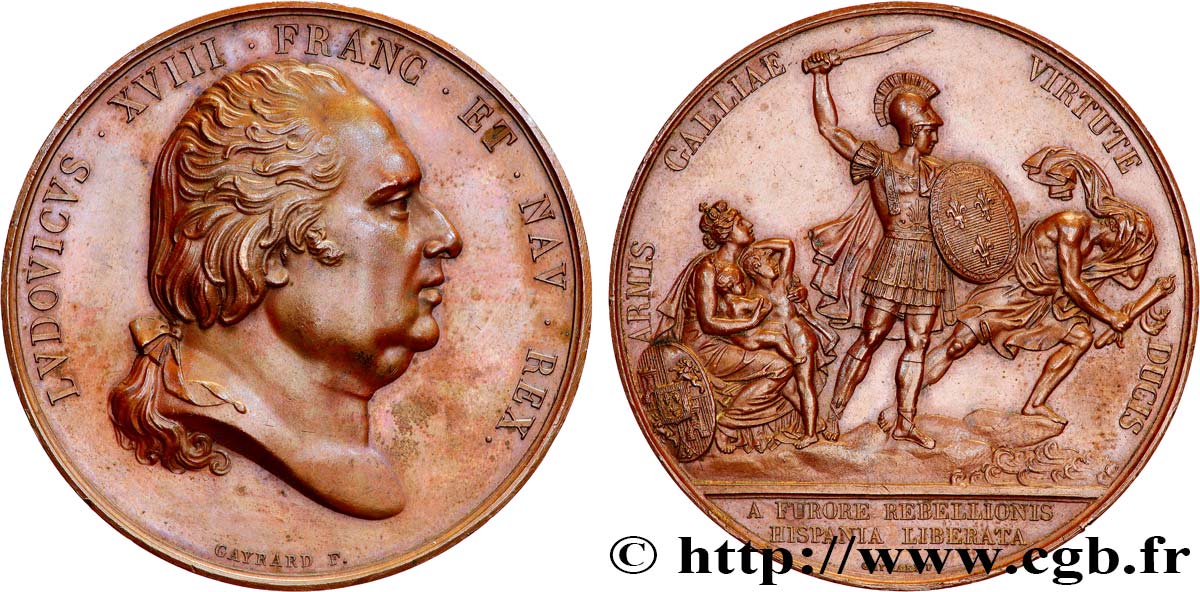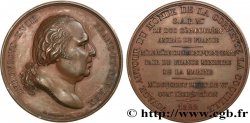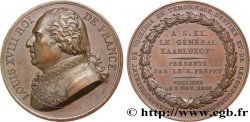fme_814301 - LOUIS XVIII Médaille, Restauration du trône d’Espagne
95.00 €(Approx. 108.30$ | 81.70£)
Quantity
Add to your cart

Type : Médaille, Restauration du trône d’Espagne
Date: 1823
Metal : copper
Diameter : 50,5 mm
Orientation dies : 12 h.
Engraver GAYRARD Raymond (1777-1858)
Weight : 71,06 g.
Edge : Lisse
Puncheon : sans poinçon
Coments on the condition:
Jolie patine marron, quelques marques d’usure sur les reliefs. Présence de quelques coups sur la tranche en particulier à 5 heures au revers
Catalogue references :
Obverse
Obverse legend : LVDOVICVS. XVIII. FRANC. ET. NAV. REX..
Obverse description : Tête de Louis XVIII à droite, signé : GAYRARD F..
Reverse
Reverse legend : ARMIS GALLIAE - VIRTUTE - DUCIS // A FURORE REBELLIONIS / HISPANIA LIBERATA.
Reverse description : Guerrier debout vêtu à l'antique brandissant le glaive, le bouclier timbré de trois lys, repoussant l'ennemi vers la mer ; à gauche, l'Espagne assise retenant deux enfants, à ses pieds un bouclier timbré aux armes de Castille et de Léon. Signé : GAYRARD F..
Commentary
La restauration absolutiste en Espagne est la période de l'histoire d'Espagne s'étendant entre 1814 et 1833, au cours de laquelle le pays connaît un rétablissement de la monarchie absolue des Bourbons.
Après la guerre d'indépendance contre l'occupant français, les Cortès se réunissent à Madrid en octobre 1813. Peu après, Napoléon reconnaît Ferdinand VII comme roi d'Espagne par le traité de Valençay. Fort du soutien de la majeure partie de la population espagnole, celui-ci rentre dans sa capitale, le 22 mars 1814, par le chemin de Valence. Il reçoit alors, de la main d'un groupe de fidèles de la monarchie, le manifeste des Perses, une déclaration favorable à une restauration absolutiste.
Début 1823, la Sainte Alliance décide d'intervenir en Espagne, ainsi qu'elle l'a déjà fait à Naples et au Piémont. Le 22 janvier un traité secret est signé qui permet à la France d'envahir l'Espagne pour rétablir Ferdinand VII en monarque absolu.
.
Après la guerre d'indépendance contre l'occupant français, les Cortès se réunissent à Madrid en octobre 1813. Peu après, Napoléon reconnaît Ferdinand VII comme roi d'Espagne par le traité de Valençay. Fort du soutien de la majeure partie de la population espagnole, celui-ci rentre dans sa capitale, le 22 mars 1814, par le chemin de Valence. Il reçoit alors, de la main d'un groupe de fidèles de la monarchie, le manifeste des Perses, une déclaration favorable à une restauration absolutiste.
Début 1823, la Sainte Alliance décide d'intervenir en Espagne, ainsi qu'elle l'a déjà fait à Naples et au Piémont. Le 22 janvier un traité secret est signé qui permet à la France d'envahir l'Espagne pour rétablir Ferdinand VII en monarque absolu.
.








 Report a mistake
Report a mistake Print the page
Print the page Share my selection
Share my selection Ask a question
Ask a question Consign / sell
Consign / sell
 Full data
Full data










